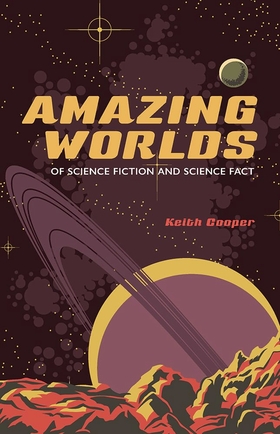Centauri Dreams
Imagining and Planning Interstellar Exploration
New Findings on Brown Dwarf Atmospheres
I often think of brown dwarfs in terms of the planets that might form around them, and the question of whether even these small ‘failed stars’ may be capable of sustaining life. Have a look, for example, at Luhman 16AB, two brown dwarfs in the Sun’s immediate neighborhood. There are some indications of a planet here which, if it were ever confirmed, would make it the second closest known exoplanet to the Earth, at least for now. We can rule out planets of Neptune mass or greater with a period of between one and two years, but future Hubble observations, already approved for August of next year, may tell us more.
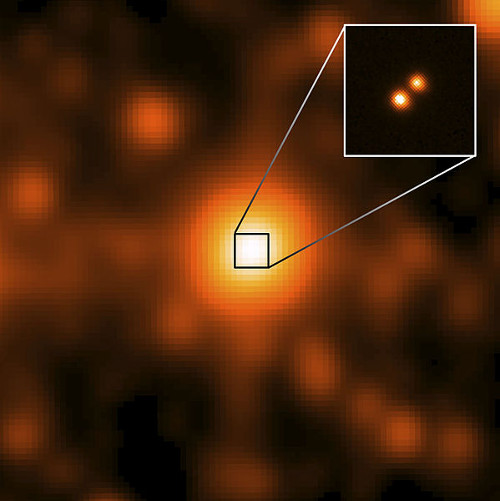
Image: Luhman 16AB, two brown dwarfs in the Sun’s neighborhood. Credit: NASA / JPL / Gemini Observatory / AURA / NSF.
But brown dwarfs, incapable of fusing chemical elements, have their own planetary characteristics. It’s this intriguing aspect of this population that gives us a kind of bridge to exoplanet systems, because brown dwarfs are often found alone, without a bright nearby star to hinder observations.
Thus we get a new paper from Daniel Apai (University of Arizona) and colleagues that looks at the weather on brown dwarfs, finding it to be similar in some ways to what we have seen on gas giants both in our own Solar System and elsewhere. And in some ways not.
Apai’s team used the Spitzer space telescope to monitor six brown dwarfs over the space of a year, observing each of them through 32 full rotations. Brightness changes are apparent as a brown dwarf rotates, due to its clouds varying throughout the atmosphere. The study of these brightness variations allows us to get a sense of how these hot clouds — largely thought to be made up of iron droplets and silicate dust — are distributed.
We already knew that brown dwarfs tend to have atmospheric storms, and it seemed reasonable to relate these to what we see on Jupiter in the form of storms like the Great Red Spot. For that matter, we can also find analogs on the other outer planets, from Saturn through Neptune, even if the kinds of clouds we find on Neptune, for example, are made of ice. And yet the brightness variations the researchers found were far more rapid than expected, with changes evident over the course of a single Earth day. That meant the model needed adjustment, at least when we move beyond Jupiter into the realm of more massive objects.
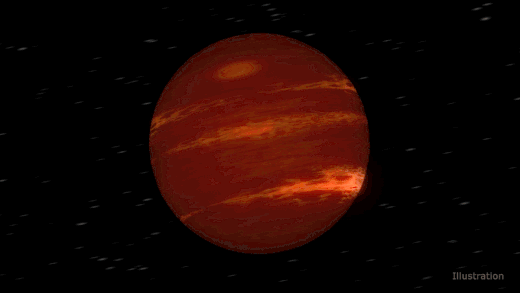
Image: This artist’s concept shows a brown dwarf with bands of clouds, thought to resemble those seen at Neptune and the other outer planets. Credit: NASA/JPL-Caltech.
The paper in Science describes the team’s work with a supercomputer and a new computer algorithm that creates maps of how clouds travel on brown dwarfs. Emerging from this is a model that involves variations in large waves moving through the atmosphere at different rates. We get, in other words, a different pattern than we see in elliptical storms like the Great Red Spot, which has persisted for centuries and changes little. On brown dwarfs, we move to the rapid propagation of waves in short time periods.
Theodora Karalidi (University of Arizona), who performed the supercomputer work on this model, says that it can explain how clouds travel on these objects:
“When the peaks of the two waves are offset, over the course of the day there are two points of maximum brightness,” Karalidi said. “When the waves are in sync, you get one large peak, making the brown dwarf twice as bright as with a single wave.”
What intriguing objects these are. Free floating brown dwarfs can be roughly the same diameter as Jupiter but far more massive, with atmospheres made up mostly of hydrogen and helium. Their cloud distribution in atmospheric bands and waves has similarities to our gas giant planets, but now we see just how changeable their cloud patterns can be in short time-frames. Thickening and thinning in a matter of hours, these hot clouds can change quickly while remaining confined to bands in different latitudes in which they move at different speeds.
Thus the brown dwarf lives up to its reputation as being something of a cross between a star and a giant planet, giving us its own unique atmospheric signature. Unlike the frenzied activity of a stellar atmosphere, brown dwarf atmospheric winds fall into regular belts and zones. But unlike the gas giants we are familiar with, they are in a state of rapid agitation and change.
Much work remains to be done, as we’re a long way from understanding the drivers of these waves. The paper is Apai et al., “Zones, spots, and planetary-scale waves beating in brown dwarf atmospheres,” Science Vol. 357, Issue 6352 (18 August 2017), pp. 683-687 (abstract).

The Future of Eclipse Science
Talk about transit depth! Those of you in the path of totality are fortunate indeed as we see just how deep a light curve can get. I’ve never experienced totality and won’t this time, but we’ll get plenty of good science out of this event and a spectacular 160 seconds for those in the path.
As the Sun’s corona is revealed, think about the solar wind — the stream of charged particles flowing from the corona out to the heliosphere — and how we might one day use similar stellar winds to brake the onrush of an interstellar probe with a magsail as it nears destination.
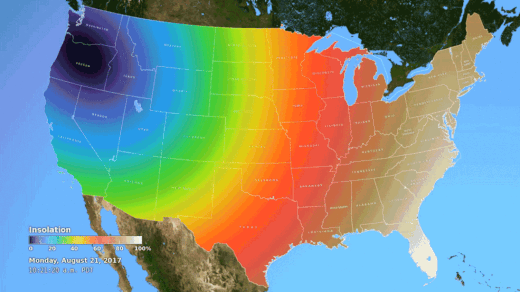
Image: The Moon’s shadow will dramatically affect insolation — the amount of sunlight reaching the ground — during the total solar eclipse. Credit: NASA’s Scientific Visualization Studio
160 seconds of totality is a fleeting but, so I’m told, haunting experience. For scientists, though, we’d like a good bit more. Thus it’s welcome news that the European Space Agency is working on Proba-3, a duo of small satellites designed to interact with each other to block the solar disk over and over again. The camera satellite and disk satellite engage in precision flying, creating artificial eclipses of six hours each time the two craft make one 19.6 hour orbit.
You would think that using a coronagraph to block out the direct light of the Sun would be sufficient, and such techniques are in use both on the ground and in space — the Solar and Heliospheric Observatory (SOHO) has been working with a coronagraph since 1996. But inserting a disk into the instrument to block out sunlight has its limitations. Andrei Zhukov (Royal Observatory of Belgium) is principal investigator for Proba-3’s coronagraph.
“The inner extent of the view afforded by standard coronagraphs is limited by stray light. Stray light is a sort of light pollution inside an instrument. In coronagraphs it is a kind of bending of the sunlight around the blocking disc. This problem can be minimised by extending the coronagraph length, the distance between the camera and the disc, as far as possible – but there are practical limits to coronagraph size. Instead, Proba-3’s coronagraph uses two craft: a camera satellite and a disc satellite. They fly together so precisely that they operate like a single coronagraph, 150 m long.”
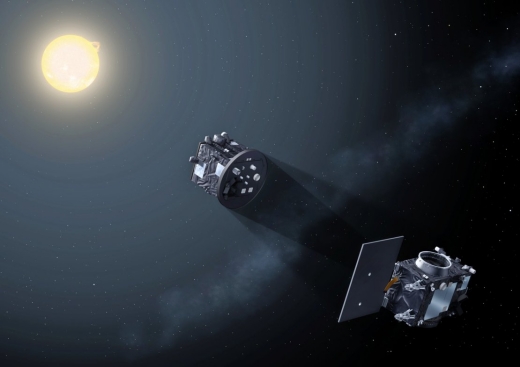
Image: Proba-3 satellites form artificial eclipse. Credit: ESA.
Does this kind of precision flying remind you of anything? The use of an occulter craft flying in formation with a second satellite brought the ‘starshade’ concept to mind when I first encountered it. The 150-meter distance between the two Proba-3 craft is much smaller, of course, as 50,000 kilometers separate starshade and telescope in some concepts.
But the idea is similar — to find a way of blocking out the light of a star so as to reveal nearby space. A starshade would give us the opportunity to actually see exoplanets around nearby stars, light which we can then analyze to understand the composition of their atmospheres. In both concepts, the key is precise positioning and maintenance of the geometry through sensors and software. Missions like Proba-3 thus become not only useful scientific probes but likewise early tests of the kind of hardware we will one day use for close-up views of exoplanets.
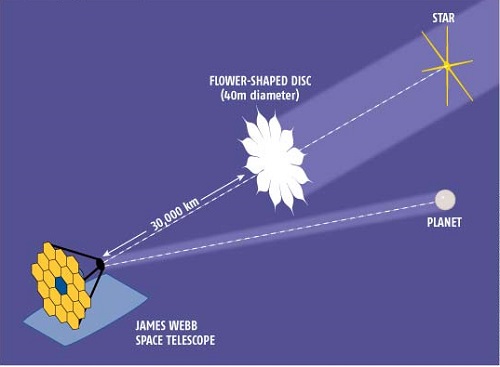
Image: A starshade blocks out light from the parent star, allowing the exoplanet under scrutiny to be revealed. Credit: University of Colorado/Northrup Grumman.
For more on starshades, see Ashley Baldwin’s WFIRST: The Starshade Option, which looks at how we might use the technology with NASA’s Wide-Field Infrared Survey Telescope. Ponder this: The superb coronagraph that will fly aboard WFIRST will be a thousand times more powerful than anything now in operation, according to an essay by JPL’s Jason Rhodes.
But WFIRST with a starshade could reach contrast ratios 10,000 times greater still. Let me quote Rhodes on the matter:
The Starshade would have to be large, about 25-40 m across for a telescope the size of WFIRST, and even larger for a bigger space telescope that could follow WFIRST, and would fly 30,000-50,000 km away from the telescope. Building a structure that large and doing the precision flying needed to align the telescope and Starshade are no small tasks, but some of our best minds are on it. The peculiar ‘flower with petals’ shape of the Starshade is to deal with the diffraction of light. A circular Starshade would cause some of the star’s light to be bent (via diffraction) directly into the telescope. However, the petals are designed to diffract the light away from the telescope, allowing us to reach that magic 10 billion to 1 contrast ratio.
The artificial eclipses made possible through a starshade are very much on the mind of the astronomical community as the idea matures. So as you enjoy today’s eclipse, consider how critical ‘eclipse science’ will become as we analyze the atmospheres of distant worlds.

Laser SETI Funded
The SETI Institute’s Laser SETI campaign made it past the finish line. Many thanks to the many Centauri Dreams readers who helped to make this happen. All sky, all the time SETI should produce astrophysical discoveries we haven’t imagined, and of course we’ll keep hoping for that intriguing transient that turns out to point to extraterrestrial intelligence. Exciting times ahead!

A Tidally Locked ‘Earth’?
Whether or not life can emerge on the planets of red dwarf stars remains an unknown, though upcoming technologies should help us learn more through the study of planetary atmospheres. Tidal locking always comes up in such discussions, an issue I always thought to be fairly recent, but now I learn that it has quite a pedigree. In a new paper from Rory Barnes, I learn that astronomers in the late 19th Century had concluded (erroneously) that Venus was tidally locked, and there followed a debate about the impact of synchronous rotation on surface conditions.
As witness astronomer N. W. Mumford, who in 1909 questioned whether tidal friction wouldn’t reduce half of Venus to a desert and annihilate all life there. Or E. V. Heward, who speculated that life could emerge on Venus despite tidal lock, and wrote in a 1903 issue of MacMillan’s Magazine:
…that between the two separate regions of perpetual night and day there must lie a wide zone of subdued rose-flushed twilight, where the climatic conditions may be well suited to the existence of a race of intelligent beings.
In terms of exoplanets, as Barnes (University of Washington) points out, Stephen Dole was writing about tidal interactions between exoplanets and their host stars in his book Habitable Planets for Man as early as 1964. It was his view, based upon his own calculations, that all potentially habitable planets orbiting stars smaller than 72% of the Sun’s mass would be in synchronous rotation, circling the star just as the Moon does our Earth.
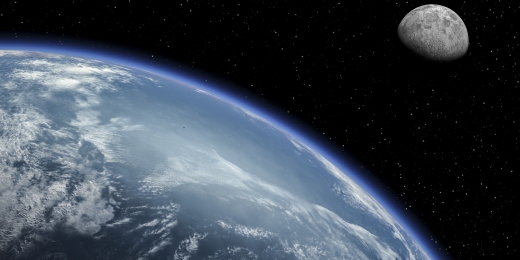
Image: Tidally locked bodies such as the Earth and Moon are in synchronous rotation, each taking as long to rotate around its own axis as it does to revolve around its host star or gravitational partner. New research from UW astronomer Rory Barnes indicates that many exoplanets to be found by coming high-powered telescopes also will probably be tidally locked — with one side permanently facing their host star, as one side of the Moon forever faces the Earth. Credit: NASA.
That would make tidal lock ubiquitous, given the high percentage of stars that are red dwarfs. The work since, beginning with James Kasting in the early 1990s and carrying through until today, has looked at how planets come into synchronous rotation, and just how this situation would affect planetary conditions. We’ve seen a shift from pessimism — such planets could not be habitable — to relative optimism, as new climate models emerged and were adjusted. Barnes’ paper gives all the particulars in a rather fascinating overview of the scholarship.
A brief look through the archives here will show that Barnes’ name comes up frequently and often on matters of tidal effects, giving him an expertise that draws my attention whenever he publishes something new on the matter. The latest paper takes a systematic look at tidal locking to arrive at the conclusion that many exoplanets — and not just those orbiting close to red dwarf stars — will be found to be tidally locked. For it turns out that earlier models used a rapidly rotating early Earth to delve into how a similar exoplanet might become tidally locked.
What Barnes did was to consider the possibility of different initial rotation periods, both slower and faster, examining conditions on planets of different sizes, including those in eccentric orbits. Widening the parameter space suggested that more exoplanets than we once thought could be tidally locked. If Earth had formed with no Moon and its initial rotation period was four days, Barnes’ calculations show one model in which it is tidally locked to the Sun by this point in its evolution. Tidal locking, then, may be a major factor in our analysis of planetary habitability.
Let me quote from the paper:
As astronomers develop technologies to directly image potentially habitable planets orbiting FGK dwarfs (e.g. Dalcanton et al. 2015), they must be prepared for the possibility that planets orbiting any of them may be tidally locked. Such a rotation state can change planetary climate, and by extension the reflected spectra. 3D models of synchronously rotating habitable planets should be applied to planets orbiting K and G dwarfs in addition to Ms. While not explicitly considered here, habitable worlds orbiting brown dwarfs and white dwarfs are even more likely to be synchronous rotators, but their potential habitability is further complicated by the luminosity evolution of the central body (Barnes and Heller 2013).
Thus we extend the quantitative assessment of tidal lock and its effects on habitability to G- and K-class stars as well as M-dwarfs. As the paper notes, “…a systematic survey of the rotational evolution of potentially habitable exoplanets using classic equilibrium tide theories has not been undertaken.”
And it has implications. We are setting about putting assets like the Transiting Exoplanet Survey Satellite (TESS), the James Webb Space Telescope (JWST) and Planetary Transits and Oscillations of stars (PLATO) into space. At the same time, we are working on Earth-based telescopes with apertures in the tens of meters. Our first targets for atmospheric characterization are going to be planets orbiting close to their host star, in the ‘habitable zone’ (or as we said yesterday, ‘temperate zone’) of the host.
The role of tidal locking is thus a crucial factor. Proxima Centauri b is most likely tidally locked, and the worlds around the highly interesting TRAPPIST-1 most likely are as well. We should learn a great deal by studying planetary rotation rates for any temperate exoplanets we find, which should give us clues as to their tidal evolution. Indeed, Barnes simulates the planets the TESS mission will examine and finds that the vast majority of these become tidally locked within a billion years, while about half the isolated (i.e., with no planetary companions) and potentially habitable Kepler candidates could be locked, assuming tidal properties like Earth’s.
A UW news release quotes Barnes on the significance of the findings:
“These results suggest that the process of tidal locking is a major factor in the evolution of most of the potentially habitable exoplanets to be discovered in the near future… I think the biggest implication going forward is that as we search for life on any exoplanets we need to know if a planet is tidally locked or not.”
The paper is Barnes, “Tidal Locking of Habitable Exoplanets,” accepted at Celestial Mechanics and Dynamical Astronomy (preprint). See also this key reference: Kasting et al., “Habitable Zones around Main Sequence Stars,” Icarus Vol. 101, Issue 1 (January, 1993), pp. 108-128 (abstract).

Is the Term ‘Habitable Zone’ Viable?
I’m not much for changing the meaning of words. True, languages always change, some at a faster clip than others (contrast Elizabethan English with today’s, though modern Icelandic is structurally very similar to the Old Norse of the sagas). But I love words and prefer to let linguistic variety evolve rather than be decreed. Even so, I get what Elizabeth Tasker is doing when she makes the case for exoplanet hunters to do away with the term ‘habitable zone.’
In a comment to Nature Astronomy, Tasker (JAXA) and quite a few colleagues point out just how misleading ‘habitable zone’ can be, given that when we find a new exoplanet, we usually only know the size of the planet (perhaps through radius, as in a transit study, or through minimum mass for radial velocity), and the amount of radiation the planet receives from its star. From such facts we can infer whether we’re dealing with a gas giant or a rocky world.
This is hardly enough on which to base a claim of habitability, but it gets worse. Among those planets where both radius and mass can be measured, we can work out an average density. Planets 40 percent larger than Earth are probably gaseous, but the cut-off is not definitive. And as to radiation from the star, this gets thorny indeed. Atmospheres come into play — consider that the equilibrium temperature on Earth is -18 degrees Celsius, at which temperature water is a solid. It takes our atmosphere to produce the 15 degree Celsius global average.
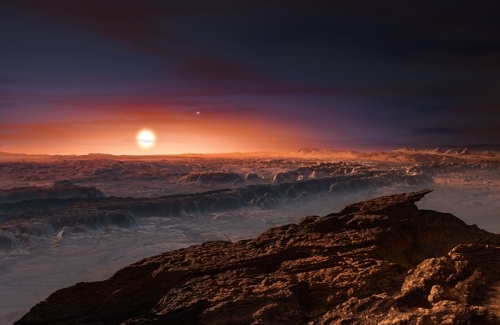
Image: An artist’s impression of Proxima Centauri b. But how much do we really know about the surface of this world? Credit: ESO/M. Kornmesser.
Equilibrium temperature is an interesting figure. It represents a surface temperature assuming a planet has no atmosphere. As Tasker and crew point out:
The heat-trapping properties of an atmosphere are highly variable, however, and depend on its thickness and gas composition. Our atmosphere raises Earth’s temperature to from below freezing to a life-friendly level. On Venus, by contrast, where the equilibrium temperature would be a comfortable 80 degrees F (about 27 degrees C), its thick atmosphere, made mostly of the greenhouse gas carbon dioxide, boosts the actual temperature to a hellish 860 degrees F (460 °degrees C), turning this Earth-size planet into an inferno hot enough to melt lead.
Arguing that ‘a quantitative measure of habitability is impossible,’ Tasker says in this Scientific American essay based on the Nature Astronomy piece that temperature and habitability don’t always go together. We can thank factors like our planet’s magnetic field for protection against the kind of solar flares that could impact the development of life. We can also thank plate tectonics, which sets up a carbon-silicate cycle, for its impact on our atmosphere. The list goes on.
Now if all this were simply a matter of lowering the expectations of headline writers, the case would be strong enough. Whenever I see a bold headline proclaiming the discovery of a ‘habitable second Earth’ or some such, I wonder how jaded the public will eventually become, especially since many such articles don’t explain how tenuous a call this really is. We want public participation in the exoplanet hunt, but we should also want the public to receive solid information. Trying to get news outlets to tone down the rhetoric, though, may not be possible.
But think ahead to the coming decade, in which we’re going to have at our disposal assets that may show us biosignatures (or not) in the atmospheres — if they are there — of planets of great interest, such as the seven worlds around TRAPPIST-1, or perhaps those interesting four planets we looked at yesterday around Tau Ceti. The reason why the astronomical community has worked so hard on the metrics for choosing which planets to look at is that these resources are going to be scarce, and we have to optimize our target list.
Thus we talk about ‘habitable zones’ where planets can have liquid water on their surface, and use such tools as the Earth Similarity Index, which lays out orbital parameters for smaller planets in a habitable zone. But again, the parameters in play come back to the two we’ve already discussed, the size of a planet and the radiation it receives from its star. A planet can be like the Earth in these two factors and still be a long way from habitability. Tasker again:
Over-interpreting these selection tools to claim they measure habitability is a dangerous game. It is absurd to suggest we can assess something as complex as life-supporting conditions based on just two properties, neither of which directly probe the relevant environment. It is equivalent to judging someone’s personality based on height and the distance between the eyes. The proliferation of such statements both in the popular media and even scientific literature risks planetary scientists being taken less seriously.
What to do? The authors of the Nature Astronomy paper want to remove the term ‘habitable zone’ altogether from the evaluation metrics astronomers use (Tasker suggests ‘temperate zone’ instead). Presumably astronomers would then stop saying they had found a planet in the ‘habitable zone,’ and the urge for misleading headlines would vanish.
I fully understand the concern these scientists are expressing and think all of us who write about these matters have an obligation to make no exaggerated claims. But as I said at the top, the pace of linguistic change over time is slow, and in this case, where hopes for finding a genuine Earth 2.0 are high, it will take more than a linguistic fiat to calm down fervid language.
By all means, go to ‘temperate zone’ within the scientific community if necessary — it makes no claims about ‘habitability’ – but I suspect our problems with foolish headlines are going to remain a part of the public experience. It takes patience to keep explaining the limitations of exoplanet science, and telling that story accurately isn’t always the way to maximize an audience. But fatigue with exaggerated headlines coupled with persistent education on these matters may eventually right the balance.
And from the standpoint of Internet commentaries, let me point out that Andrew Le Page, on his Drew ex Machina site, has proven the gold standard at analyzing each new claim. His ‘habitable planet reality checks’ are long on analysis and utterly devoid of hype. Slow and persistent, that’s the way to proceed, and at each step of the process, Drew gets it right.
The paper is Tasker et al., “The language of exoplanet ranking metrics needs to change,” Nature Astronomy Vol. 1, 0042 (2017). Abstract.

Tuning Up RV: A Test Case at Tau Ceti
The new work on Tau Ceti, which analyzes radial velocity data showing four planets there, looks to be a step forward in this workhouse method for planetary detection. With radial velocity, we’re analyzing tiny variations in the movement of a star as it is affected by the planets around it. These are tiny signals, and the new Tau Ceti paper discusses working with variations as low as 30 centimeters per second. It’s a good number, but we’ll want better — to detect a true Earth analog around a Sun-like star, we need to get this number into the 10 cm/s range.
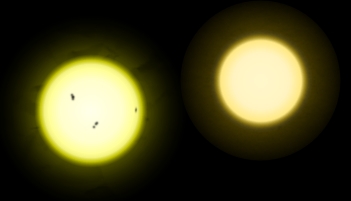
The planets detected in this work all come in at less than four Earth masses, and two of them are getting attention because they are located near the inner and outer edges of the habitable zone respectively. Tau Ceti has always drawn our attention, being relatively close (12 light years) and a solitary G-class Sun-like star. No wonder it and Epsilon Eridani were the two targets Frank Drake chose for Project Ozma when he launched observational SETI in 1960.
Image: This illustration compares the somewhat larger and hotter Sun (left) to the relatively inactive star Tau Ceti. Credit: R.J. Hall / Wikimedia Commons.
The idea that there are planets around Tau Ceti is not new, but the current study, led by Fabo Feng (University of Hertfordshire, UK) re-examines the star and actually eliminates two of the candidate planets identified four years ago. Radial velocity depends on picking out the faint signature of planets against ‘noise’ such as activity on the surface of the star, the rotation of the star, and uneven sampling times from observations. This is why validating some RV planet candidates can be tricky. Feng and team, however, have applied a new method.
This is the same team that did the 2013 paper on Tau Ceti, using the nearby star as a test case for its methods. The idea was to examine how activity on Tau Ceti itself differed when observed in a range of wavelengths. The thinking here is that the ‘jitter’ in variations of the radial velocity signal is dependent on wavelength, which needs to be accounted for in the analysis.
To do this, the authors introduce what they call “differential RVs.” The radial velocity signals of planets do not depend on wavelength, so differential RVs are those that contain only the noise that needs to be screened. Working with 9000 measurements of the star from the HARPS spectroscope, including new measurements, the team found four strong planet candidates.
The signals are consistent with orbits of 20.0, 49.3, 160 and 642 days. This is an interesting mix given the earlier work, as it identifies two new RV signals (20 and 49.3 days), while tightening up the precision on the previously identified candidates at 160 and 600 days, and at the same time ruling out two of the candidates identified in 2013. “But no matter how we look at the star,” says Mikko Tuomi (University of Hertfordshire), “there seems to be at least four rocky planets orbiting it.”
We’re learning something crucial here about how radial velocity methods work. Remember that we thought for a time that we had identified a planet around Alpha Centauri B, a detection that was later acknowledged to be a mistake in the analysis. When we’re dealing with planets of roughly Earth’s size, the radial velocity signals we can expect even from nearby stars are well below 1 meter per second. The complexity of the problem in relation to Tau Ceti is evident:
The planetary candidates we have identified partially overlap with the ones found by MT13 [the authors’ 2013 paper on Tau Ceti RV analysis]. We find two new planetary candidates with periods around 20 and 49 d, but fail to confirm the signals around 14 and 35 d. Although there is evidence for the existence of the signal at around 92 d, we cannot confirm it as a Keplerian candidate because it cannot be consistently identified in all data sets and solutions. The signal around 14 d becomes weak when we subtract the 20 d signal from the data. But the opposite is not true, suggesting a non-Keplerian origin of the 14 d signal. Nevertheless, the 14 d signal does exist in some Keplerian and circular solutions after accounting for the 20 d signal. In addition, by evenly dividing the data into 3 chunks, we find that the 14 d is significant in the first chunk while the 20 d is significant in the second and third chunks…
And so on. The lesson is clear enough: We have to be extremely careful when interpreting signals below 1 meter per second, the range in which we’ll need to identify Earth-class planets.
But the value of radial velocity is unquestioned. Unlike the transit technique, we don’t have to rely on a fortuitous line-up between a distant planetary system and the Earth — we can therefore extend it to all bright stars of interest. Feng and colleagues think we will be able to use new high precision spectrometers along with these emerging statistical and noise models to find a true Earth analog in the coming decade. Thus this work on Tau Ceti, modeling wavelength-dependent noise, becomes a test case of a new noise model framework that can help us filter background noise out of RV observations.
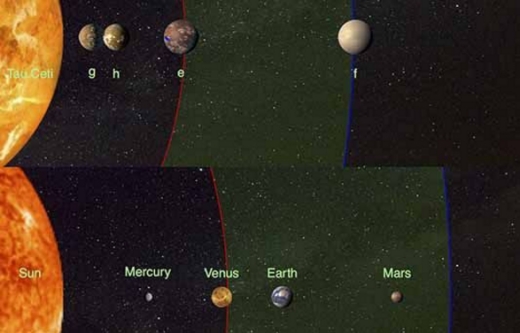
Image: The four planet candidates at Tau Ceti in comparison with our Solar System. Credit: University of Hertfordshire.
And while two of these planets (e and f) have been cited as being close to the boundaries of the habitable zone, the massive debris disk around Tau Ceti is going to be a factor in habitability in this system, leading to presumed cometary bombardment. We’ll want to learn more about the inner boundaries of the debris disk, and also whether the disk and planetary system orbit in the same plane, which would have a strong effect on the masses of these planet candidates. A co-planar disk brings the mass estimates of these four planets up sharply.
The paper is Feng et al., “Color difference makes a difference: four planet candidates around tau Ceti,” accepted at the Astronomical Journal (preprint).

